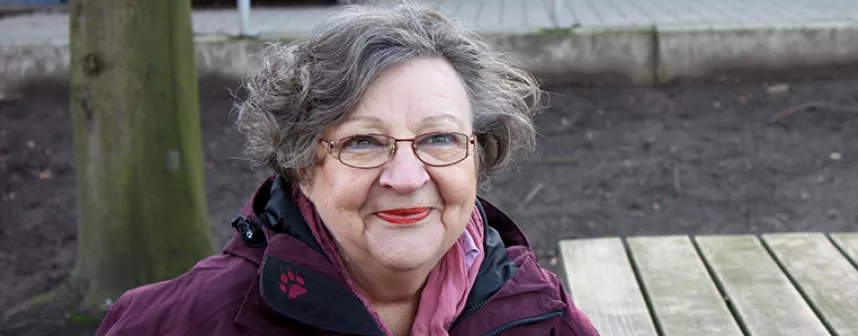Marija de Gast: the mother of the blue village
March 13, 2019
"Mama Marija" - that's what the kids called her. Up to 60 of them were in the blue village at the height of the refugee wave. For each one of them she had something sweet and a warm hug in her office. "The blue village was my baby," says Marija de Gast. The former director of the refugee shelter on Steingutstraße in Bremen Grohn formed it into a showpiece. "And that only worked out with the help of Jacobs University’s students," says the 68-year-old. From the very beginning, students of the international university have supported the residents of the refugee shelter – and still do so today.
The neighbors’ scepticism was great at the end of 2014 when the temporary home consisting of housing containers was built on the industrial wasteland on Steingutstraße, less than a five minutes' walk from Jacobs University. Marija lives just around the corner. "Maybe that's why I wanted it to be especially good. People should see that such accommodation doesn't automatically cause problems."
The native Bosnian came to Bremen at the beginning of the 90s, together with her son and her husband, a Dutchman who worked for Bremen’s tourist office. They got to know each other during their time as tour guides in Croatia. When she arrived in the hanseatic city, she experienced a wave of refugees from her homeland, caused by the Balkan war. "I speak the language, I wanted to help," she says and got involved with the Workers' Welfare Association, and soon took over the management of a shelter. "I have worked in many of them, but never have I enjoyed going to work as much as in the blue village".
Blue is the color of the accommodation containers that form the blue village. The fact that they were set up not only triggered reservations, but also an enormous willingness to help. A welcome initiative was founded, the students of Jacobs University supported the project from the very beginning. The first 20 refugees from Syria even slept temporarily on the neighboring campus.
"The commitment of the students was and is touching. We were like one big family," says Marija de Gast. There was some kind of initiative almost every day: Painting courses for children and women, for example. The students did sports with them or music, made pottery, baked biscuits, hid Easter eggs on the campus or organized a Christmas party. Money was also donated. Students rowed the 3078 kilometers from Bremen to Damascus on their ergometers - and collected around 7000 euros for the blue village.
Helping wherever she can, approaching challenges with a lot of heart – that's what Marija de Gast is all about. "I'm not very interested in numbers, I'm interested in people," she says. Until the summer of last year, she ran the home but her work for the refugees has remained to this day. She stops by almost every day and takes special care of two families with severely handicapped children. "I can't get away from the blue village," she says smilingly.
The students ofJacobs University also continue to be involved. Twice a week they playfully teach the children German and help them with their homework. "This is very important for the children," says Hasan Gedik, the current director of the shelter. "When the students come, the children run towards them with their arms outstretched. They are like big siblings, that's very nice to see."
This article is part of the series “Faces of Jacobs”, in which Jacobs University introduces students, alumni, professors, staff members and friends of Jacobs University.
